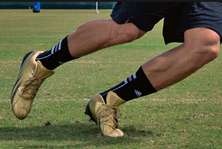 For years I have heard coaches use the term "Push" when trying to get athletes to move more explosively. "Push off your feet!" Sounds familiar right? Well that;s fine and all for average athletes, but if you really want speed, who doesn't, then you need to start replacing the word "push" with the action word of "punch." Here is why: pushing the ground away can/will make your feet spend a longer time of the ground, thus reducing speed. By using the power phrase of "punch," you will drive more force through the ground, while having your feet feel more spring-like. To feel what I am talking about, simply perform 5 reps on a jump rope saying "push" as you land then perform 5 reps saying "punch" right before your feet contact the ground. No, seriously try it! That is what every cut, acceleration and change of direction needs to feel like. One other coaching cue that is vital to this term of "punching" is to shift your center of gravity away from your heels and forward (or any other angle). So to feel this, Sprint 2 steps (from a standing position), then sprint 2 steps saying "Punch-Punch" after you first fall forward with your heels off the ground. You are now quicker! Don't waist your talent, release your inner athlete by getting StrongerQuicker! Written By: Ryan Bishel, BA, PES Like this article? Thank me by sharing it or give it a "LIKE!"
4 Comments
 Gaining inches of vertical can be challenging due to many factors. That's why you are probably asking yourself: "How do I jump higher?" "...How do I gain more inches of vertical?" Well here are 5 key factors that all contribute to an increase in vertical jump height and athletic performance. (Well "Cat-Like" Reflexes help too) #1) Warm-ups Warming up is important when playing. This is because it can stimulate the energy within our body & warm up your muscles, making it easier to propel your body upwards. Try not warming up and look at the height of your jump. Record the 1st jump and then do a 10-15min warm-up. Jump again after the warm up. You will see a difference. #2) Relative Strength Example: A 150lb athlete that squats 300lbs has more Relative Strength than a 200lb athlete that also squats 300lbs. Science says: Less mass means less gravity. It also says: Stronger muscles & Maximal Strength produce more force. Now when both are combined together, this is called Relative Strength. To propel your body up and jump higher than normal, these two must be focused on regularly. It's pretty simple really, just think of the quickest, most explosive athletes you know, they are both lean and are strong. Action: Lose body fat & get your body stronger and more powerful so in turn, you will be "Lighter relative to yourself" [Relative Strength]. Helpful exercises include: Upper Body Exercises, Abdominal Exercises, Squats, Calf Raises, Hip Flexor Exercises, Transverse abdominal/oblique exercises #3) Flexibility Do this everyday and you will increase your range of motion. Note: there are 2 mandatory types of flexibility: Dynamic (walking lunges, leg swings, etc) and Static (touching your toes, calf stretch, etc). Pre = Dynamic, Post = Static. #4) Plyometrics They improve the overall nervous system. Helpful exercises include: Jump Roping, Bounding & Ladder Drills. #5) Body Positioning & Movement Mechanics Place your hips at 30-40 degrees, your knees at 60-70 degrees, your ankles at 25-30 degrees all while swinging your arms behind you. Explode upwards using the energy from your leg muscles with a rapid upward arm swing. Note: Make sure there is a quick transition from down to up... Your muscles will store energy that will be released as you move up, helping you gain inches. By: Ryan Bishel, BA, PES |
Details
AuthorRyan Bishel, BA, PES has been coaching athletes since 1999. Numerous athletes have competed in NCAA athletics and professional sports. Archives
October 2014
Categories |

 RSS Feed
RSS Feed
